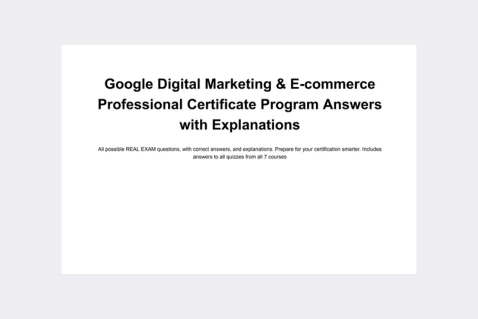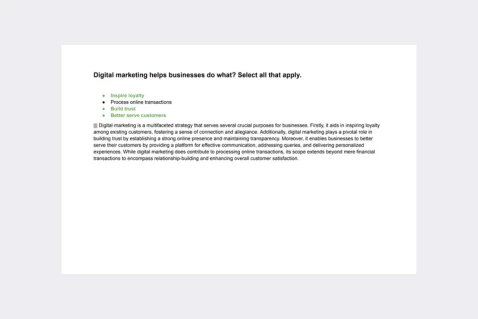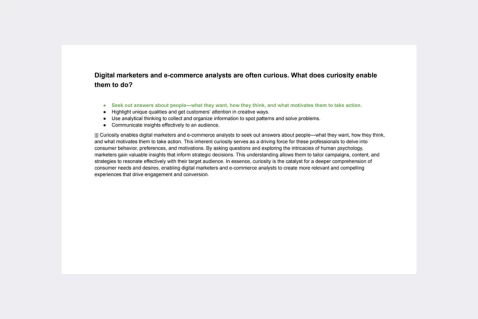Fill in the blank: When brands _____ their lists, it makes it easier to build relationships with customers.
segment
ignore
spend less on
spam
Certification program: 👉 Google Digital Marketing & E-commerce Professional Certificate (Coursera)
Explanation: When brands segment their lists, it makes it easier to build relationships with customers. List segmentation involves categorizing a brand’s audience into distinct groups based on specific criteria such as demographics, behavior, or preferences. This targeted approach allows brands to tailor their communication and marketing strategies to the unique needs and interests of each segment. By understanding the diverse characteristics of their audience, brands can deliver more relevant content, personalized experiences, and targeted offers. This not only enhances customer satisfaction but also fosters stronger connections and loyalty. In contrast, ignoring or spamming the audience can lead to a deterioration of relationships and a negative impact on the brand’s reputation. Segmenting lists is a strategic practice that contributes to effective and meaningful engagement with customers.
Passing exams is not a workout. Multiple attempts won’t make you stronger.



- All possible certificate program questions
- Real certification exam questions
- Detailed answer explanations.
- Over 1700 questions, 7 courses, 30 quizzes
- Free lifetime updates.
The Importance of Segmenting Your Email Lists for Building Strong Customer Relationships
In the realm of email marketing, one of the most valuable practices for brands is segmenting their email lists. By segmenting their lists, brands can tailor their messages to specific audience segments, delivering more relevant and personalized content to their subscribers. But why is this segmentation crucial, and how does it contribute to building stronger relationships with customers?
Understanding Email List Segmentation
Email list segmentation involves dividing a brand’s email subscriber list into smaller, targeted segments based on specific criteria such as demographics, behaviors, interests, or purchase history. These segments allow brands to send more targeted and personalized email campaigns that resonate with each group of subscribers.
The Benefits of Email List Segmentation
Segmenting your email lists offers several key benefits for building stronger customer relationships:
1. Personalization:
Segmented email campaigns enable brands to deliver more personalized content to their subscribers. By tailoring messages to the specific interests and preferences of each segment, brands can create a more engaging and relevant experience for their subscribers, leading to higher open rates, click-through rates, and conversions.
2. Improved Engagement:
Segmented email campaigns are more likely to resonate with recipients, leading to higher levels of engagement. When subscribers receive content that is relevant to their needs and interests, they are more likely to interact with the email, click through to the website, and take desired actions, such as making a purchase or signing up for a webinar.
3. Enhanced Customer Loyalty:
By delivering targeted and personalized content, brands can strengthen their relationships with customers and foster greater loyalty and trust. When subscribers feel understood and valued, they are more likely to remain engaged with the brand over time, leading to increased customer lifetime value and repeat purchases.
4. Better Return on Investment (ROI):
Segmented email campaigns tend to perform better than non-segmented campaigns in terms of ROI. By delivering more relevant content to subscribers, brands can achieve higher conversion rates and sales, resulting in a greater return on their email marketing investment.
Practical Insights
Here are some practical insights to help brands effectively segment their email lists:
-
Collect Relevant Data: Gather data on your subscribers’ demographics, behaviors, interests, and purchase history. Use this data to create meaningful segments that align with your marketing objectives and target audience.
-
Define Segmentation Criteria: Determine the criteria you will use to segment your email lists, such as age, gender, location, past purchase behavior, or engagement level. Aim to create segments that are meaningful and actionable for your email marketing campaigns.
-
Test and Iterate: Experiment with different segmentation strategies and monitor the performance of your email campaigns. Use A/B testing to compare the effectiveness of segmented versus non-segmented campaigns and iterate based on the results.
-
Automate Segmentation: Leverage email marketing automation tools to streamline the process of segmenting your email lists. Set up automated workflows to dynamically segment subscribers based on their actions, preferences, or lifecycle stage.
In conclusion, segmenting your email lists is a critical practice for brands looking to build stronger relationships with their customers. By delivering more personalized and relevant content, brands can enhance engagement, loyalty, and ROI, ultimately driving long-term success in email marketing.
Remember, in the age of inbox overload, segmentation is the key to standing out and connecting with your subscribers on a deeper level.
Discover our best-value guides
- Special Bundle Offer Google_Ads_Roll
- Special Bundle Offer HubSpot_Exams_Roll
- Special Offer Unchained_Guru_Roll
- Special Bundle Offer Amazon_Roll
- Special Bundle Offer Google_Analytics_Roll
- Special Bundle Offer Google_SkillShop_Roll
- Special Bundle Offer Marketing_Platforms_Roll
- Special Bundle Offer Microsoft_Advertising_Roll
- Special Bundle Offer YouTube_Roll
- Special Bundle Offer Google_Android_Roll
- Ultimate PMP certification preperation guide
- Google Cloud Professional Architect Certification Exam Answers - Ultimate Guide
- Special Bundle Offer SEMrush_Roll